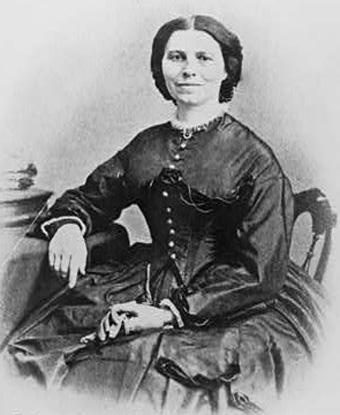Last updated: March 9, 2022
Person
Clara Barton

Library of Congress
Clara Barton's Lifetime of Service
Clarissa "Clara" Harlowe Barton was born in North Oxford, Massachusetts in 1821, the youngest of Stephen and Sarah Barton's five children. When Clara Barton was 11 years old, her older brother David fell from a rafter in a barn he was helping to build. She spent the next two years caring for him by administering all of his medicines, which included the application of leeches.
In 1854, she moved to Washington, D.C. where she became one of only a few female clerks at the US Patent Office and the only woman in her office receiving a salary equal to the male clerks. On April 19, 1861 a trainload of Massachusetts men responding to President Lincoln's call for Union soldiers were attacked in a Baltimore, Maryland riot. After arriving in Washington, D.C. they were sent to a makeshift hospital housed in the US Senate chamber. Clara Barton brought them food and supplies and tended to their needs. Following the First Battle of Manassas, she cared for the wounded as they returned to Washington, D.C. In 1862, after constant badgering of political and military chiefs, she was finally granted passes to the front.
Following the Battle of Cedar Mountain, she appeared at a field hospital around midnight with a wagon-load of supplies. The beleaguered field surgeon later likened her to an angel, which led to her nickname, "the angel of the battlefield." Clara Barton continued to aid wounded on the front lines, including at the Battle of Antietam. Arriving at the northern edge of the infamous "Cornfield" at about noon, she watched as harried surgeons dressed the soldiers' wounds with corn husks. They were forced to use anything they could find because the supply trains were so far behind the fast-moving troops on the field at Antietam. Upon her arrival, Barton quickly handed over to grateful surgeons a wagon load of bandages and other medical supplies that she had personally collected over the past year.
After passing on her supplies to the surgeons Miss Barton got down to work. As bullets whizzed overhead and artillery boomed in the distance, Miss Barton cradled the heads of suffering soldiers, prepared food for them in a local farm house, and brought water to the wounded men. As she knelt down to give one man a drink, she felt her sleeve quiver. She looked down, noticed a bullet hole in her sleeve, and then discovered that the bullet had killed the man she had been helping.
Undaunted, the unlikely figure in her bonnet, red bow, and dark skirt moved on--and on, and on. Working non-stop until dark, Barton comforted the men and assisted the surgeons with their work. When night fell, the surgeons were stymied again--this time by lack of light. She then produced some lanterns from her wagon of supplies, and the thankful doctors went back to work.
Barton's timely arrival at the battlefield had not been easy. Only the day before, her wagon had been mired near the back of the army's massive supply line. Prodded by Barton, her teamsters drove the mules all night to get closer to the front of the line.
Within a few days after the battle, the Confederates had retreated and wagons of extra medical supplies were rolling into Sharpsburg, MD. Barton collapsed from lack of sleep and a budding case of typhoid fever. She returned to Washington lying in a wagon, exhausted and delirious. She soon regained her strength and returned to the battlefields of the Civil War.
In 1863, Barton traveled to the Union-controlled Sea Islands south of Charleston, South Carolina. On July 14, 1863 she moved from Hilton Head Island to Morris Island to tend the growing number of sick and wounded soldiers - a list that greatly increased after the failed Union assault on Battery Wagner on July 18, 1863.
Later in the Morris Island campaign, Barton passed out fresh food and mail to the men in the trenches. Because of her exposure to the terrible, unsanitary conditions endured by the soldiers, she herself became gravely ill and was evacuated to Hilton Head. She later wrote of the largely forgotten campaign:
“We have captured one fort - Gregg - and one charnel house - Wagner - and we have built one cemetery, Morris Island. The thousand little sand-hills that in the pale moonlight are a thousand headstones, and the restless ocean waves that roll and breakup on the whitened beach sing an eternal requiem to the toll-worn gallant dead who sleep beside.”
In 1864, she was appointed by Maj. Gen. Benjamin Butler as the "lady in charge" of the hospitals of the Army of the James. After the war ended, Barton continued her work as a humanitarian. She established The Office of Correspondence with Friends of the Missing Men of the United States Army and directed a four-year search for missing soldiers. She also accompanied an army expedition that identified and marked the graves of nearly 13,000 Union prisoners of war and established the Andersonville National Cemetery in Georgia.
Clara Barton is probably best known for her founding of the American Red Cross, for which she was also the first president. She led the organization for twenty-three years. It was her idea to incorporate natural disaster relief into the core mission of the American Red Cross. This idea was adopted by the International Red Cross and her influence changed the course of world-wide relief that carries forward to this day. So it may well be said that the success of the American Red Cross is largely due to the hands on battlefield experience of Clara Barton during the Civil War. She is truly the Angel of the Battlefield and a great American hero.
